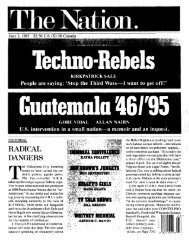Illan Nam, Colgate University, Feb 2011Draft <strong>in</strong> progress, please do not quote or citeeffect on welfare spend<strong>in</strong>g <strong>in</strong> LDCs. Rudra’s results affirmed that governments’commitments to welfare spend<strong>in</strong>g depend on strong labor-market <strong>in</strong>stitutions. 24Notwithstand<strong>in</strong>g these <strong>in</strong>sights, the literature’s exploration of globalization’seffects leaves several important lacunae that merit further <strong>in</strong>vestigation. One area thatcompels further <strong>in</strong>quiry is whether deepened <strong>in</strong>tegration yielded comparable effects upondifferent segments of workers. Along with greater trade and capital openness, employers<strong>in</strong> advanced as well as develop<strong>in</strong>g countries <strong>in</strong>creas<strong>in</strong>gly embraced flexible or atypicalhir<strong>in</strong>g practices dur<strong>in</strong>g the 1990s, as they turned to temporary and part-time contracts aswell as sub-contract<strong>in</strong>g that permitted them to shed workers more easily and to m<strong>in</strong>imizethe costs of pay<strong>in</strong>g employees welfare benefits. 25These developments are thought tohave produced new fissures <strong>in</strong> the labor market between workers with secureemployment (<strong>in</strong>siders) and those who face more precarious terms of employment(outsiders) (Rueda). These different groups of labor market participants are viewed tocomprise dist<strong>in</strong>ct voter constituencies with disparate policy preferences and <strong>in</strong>terests.Yet, it is not clear that the boundary between the preferences of these groups is asimpermeable outside of the OECD. Given that employment protection legislation <strong>in</strong> themiddle-<strong>in</strong>come develop<strong>in</strong>g countries is weaker than it is <strong>in</strong> OECD countries, it seemsplausible that the boundary between formal and <strong>in</strong>formal sector workers might be lesshardened <strong>in</strong> <strong>East</strong> <strong>Asia</strong> and Lat<strong>in</strong> America. This raises the question of whether, <strong>in</strong> thesecountries that manifest weaker EPL for formal sector workers, the pressures ofglobalization generated more possibilities for <strong>in</strong>formal and formal sector workers to24 Nita Rudra, “Globalization and the Decl<strong>in</strong>e of the Welfare State <strong>in</strong> Less-Developed Countries”International Organization 56:2 (2002)25 OECD, Employment Outlook, several years, Kev<strong>in</strong> Gray, Korean Workers and Neoliberal Globalization(London: Routledge, 2008), Kirsten Sehnbruch, The Chilean Labor Market (New York: Palgrave, 2006)18
Illan Nam, Colgate University, Feb 2011Draft <strong>in</strong> progress, please do not quote or citerecognize a common ground of shared <strong>in</strong>terests, yield<strong>in</strong>g greater scope for alliances andcoalitions to be formed across segments with<strong>in</strong> the labor force.Second, the globalization literature tends to focus on levels of social spend<strong>in</strong>g asthe measure of <strong>in</strong>terest. In privileg<strong>in</strong>g the importance of expenditures, the literature risksoverlook<strong>in</strong>g other equally, if not more important aspects of welfare policy such as theextent of redistribution and risk pool<strong>in</strong>g that perhaps more <strong>in</strong>cisively captures howglobalization shapes the political dynamic beh<strong>in</strong>d the welfare policy debate. Toparaphrase Esp<strong>in</strong>g-Anderson, to assume that all spend<strong>in</strong>g counts equally may be quitemislead<strong>in</strong>g. For <strong>in</strong>stance, a country’s welfare spend<strong>in</strong>g may be high because it allocatesgenerous benefits to a privileged group such as civil servants. Conversely, the costs<strong>in</strong>curred by a universal program that offers benefits to all citizens depend on thegenerosity of these benefits. If a universal program extends low levels of benefits, theoverall costs of the program may not be higher than that of a corporatist or liberal regime.Consequently, focus<strong>in</strong>g on spend<strong>in</strong>g levels or changes <strong>in</strong> spend<strong>in</strong>g levels may notbe as illum<strong>in</strong>at<strong>in</strong>g as identify<strong>in</strong>g how these monies have been spent. As a case <strong>in</strong> po<strong>in</strong>t,total health spend<strong>in</strong>g <strong>in</strong> South Korea, Thailand, and Chile, for <strong>in</strong>stance, is roughly equalat around 6% of GDP. Notwithstand<strong>in</strong>g this, the programs are established uponcontrast<strong>in</strong>g objectives that are underscored by different rules regard<strong>in</strong>g the eligibility ofparticipation and benefits for groups of citizens. This choice of program type has at leastas much, if not more, to do with how groups contest the allocation of f<strong>in</strong>anc<strong>in</strong>g,redistribution of <strong>in</strong>come, and pool<strong>in</strong>g of risk than merely spend<strong>in</strong>g. Voters and <strong>in</strong>terestgroups weigh not only the costs of the program, which often rema<strong>in</strong> variable and<strong>in</strong>determ<strong>in</strong>ate dur<strong>in</strong>g much of the policy discussion, but also what they stand to lose or19
- Page 1 and 2: Illan Nam, Colgate University, Feb
- Page 3 and 4: Illan Nam, Colgate University, Feb
- Page 5 and 6: Illan Nam, Colgate University, Feb
- Page 7 and 8: Illan Nam, Colgate University, Feb
- Page 9 and 10: Illan Nam, Colgate University, Feb
- Page 11 and 12: Illan Nam, Colgate University, Feb
- Page 13: Illan Nam, Colgate University, Feb
- Page 16 and 17: Illan Nam, Colgate University, Feb
- Page 20 and 21: Illan Nam, Colgate University, Feb
- Page 22 and 23: Illan Nam, Colgate University, Feb
- Page 24 and 25: Illan Nam, Colgate University, Feb
- Page 26 and 27: Illan Nam, Colgate University, Feb
- Page 28 and 29: Illan Nam, Colgate University, Feb
- Page 30 and 31: Table 2 - Electoral Volatility Acro
- Page 32 and 33: Illan Nam, Colgate University, Feb
- Page 34 and 35: Illan Nam, Colgate University, Feb













